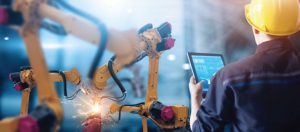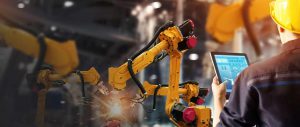Our Six Takeaways from our Participation at IMPACT Summer 2021
The pandemic has buffeted manufacturers in every sector. Companies serving the thriving industries have experienced a sharp increase in demand, while others have suffered. The manufacturers are increasingly aware that even when the pandemic subsides, it will leave a lasting impact, and they will need to transform their businesses to adapt to a new normal.
The Changing Paradigm in the Wake of the Pandemic
Evolution stems from real challenges, and in the manufacturing case, the pain is driven by volatile market demand, evolved business realities and fierce competition between companies that no organization can win without adopting smart technologies. The pandemic spotlighted the need for digital transformation and Industry 4.0, which earlier was a “good to have” option and has become critical for survival, recovery and sustenance. As a result, everyone in the manufacturing world is talking about smart manufacturing. This digitization is creating the fourth industrial revolution and transforming manufacturing back into an economic powerhouse.
Motherson Technology Services participated in IMPACT Smart Manufacturing, and R&D Virtual Summit Summer 2021 as a solution provider, and below are key trends that we observed during conversations at the event:
Trend 1: Sitting on the Fence
COVID-19 has shown that companies need to move to more digitally enabled flexible manufacturing and supply chain models. The challenging market conditions drive companies to think differently about their manufacturing operations, especially the SMB segment, which is now where Fortune 500 companies were almost a decade ago on the technology adoption journey.
In other words, it has given the opportunity to transform factories and supply chains, and this time, the businesses are optimistic about becoming Smart. They have started to understand the profound importance of manufacturing operations and are developing new and exciting visions for the future. As a result, many manufacturers are looking to transform their business models and build value chains through smart manufacturing.
Trend 2: Smart, Connected Products: The Key to the Future of Manufacturing
As the manufacturing sector sees the benefits of a connected world, there is a rise in the adoption of connected products and technologies such as RPA. Advanced, customized products attract new customer groups, enhance customer experiences, improve competitive differentiation, and drive new sources of revenue.
An M&M report suggests that the global connected device analytics market size is expected to increase to USD 40.3 billion by 2025, at a 23% CAGR. This trend is an indicator of the reason why manufacturers are attracted to join the connected revolution.
However, manufacturers need to rethink their business models using digital technologies and scale up fast to grasp these new opportunities.
Trend 3: Deciding on the Practicalities
Although the industry is convinced of being in the midst of the fourth industrial revolution, the story is yet to be written. Due to the lack of business use cases, the companies are not ready to instantly go with the change. The challenge is to add even more power to the revolution to ensure a global, substantial, and long-lasting impact.
Manufacturers need to understand the big picture of smart manufacturing to assess their efforts and better understand their priorities, which is necessary to create a unified approach and direction. Also, they need to have a transparent outlook on the areas to focus on, whether material management and saving, quality control and optimization or perhaps tool and inventory management. This initial exploration stage is essential to lead to smart conclusions and enable businesses to go digital.
Trend 4: Digital Work Instructions for the New Age Worker
A significant priority area for the manufacturers is the investment in technology to train their existing workforce remotely using next-gen technologies like AR driven offsite training. Many companies are struggling with a dwindling workforce. Therefore, to successfully implement new technology and maintain operations, the companies are striving to have a workforce that possesses “digital dexterity”- the ability to understand both the manufacturing processes and the digital tools that support these processes.
They are looking forward to balancing the hiring with external experts and internal staff to grow their digital skills.
Trend 5: Keeping the Four Walls Safe
There is an increasing trend towards the need for smart warehousing/ smart warehouse management. The warehousing business is experiencing a considerable transformation and is now being used by companies to keep up with customer requests and speed up shipping. Due to the dramatic shift in customer purchasing behavior during the Covid-19 pandemic, there has been a rise in installing real-time warehouse management system software solutions for effective order processing, packing and shipping.
Consequently, organizations are looking forward to investing in AI technologies into their warehouse to streamline operations. They are looking to invest in track and trace technologies. While warehouse automation has significant upfront costs, it has many benefits that help enhance productivity in the long run.
Trend 6: Old is the New Gold
The overnight shift to the remote working model highlighted the drawbacks of the physical infrastructure companies relied upon earlier. Now there is a massive push for modernizing the legacy applications. However, manufacturers do not want to spend a fortune and endless resources setting up new tools while coordinating or closing data gaps between systems.
In other words, businesses look forward to retaining their legacy systems while embracing the new technology, which is an easier path towards innovation and enables them to make smaller adjustments and add intelligence, sensors, and automation on top of the existing structure. They are adding new technology layers on top of legacy systems that continue working as before. This simplifies Industry 4.0 onboarding.
The Way Ahead
As manufacturers pave their path towards rebuilding their future, they must adapt to multiple transformations, often by changing processes and practices that they have grown accustomed to. While they may not be able to invest in full-scale automation all at once, midsize manufacturers may explore the edges of their manufacturing processes, identifying one or two areas that could be automated.
By keeping pace with the latest trends, they can stay ahead and position themselves to deal with the next disruptive event whenever it comes along.
About the Author:

Arun Mohanchandra: Business Head (Motherson Technology Services USA Limited)















































